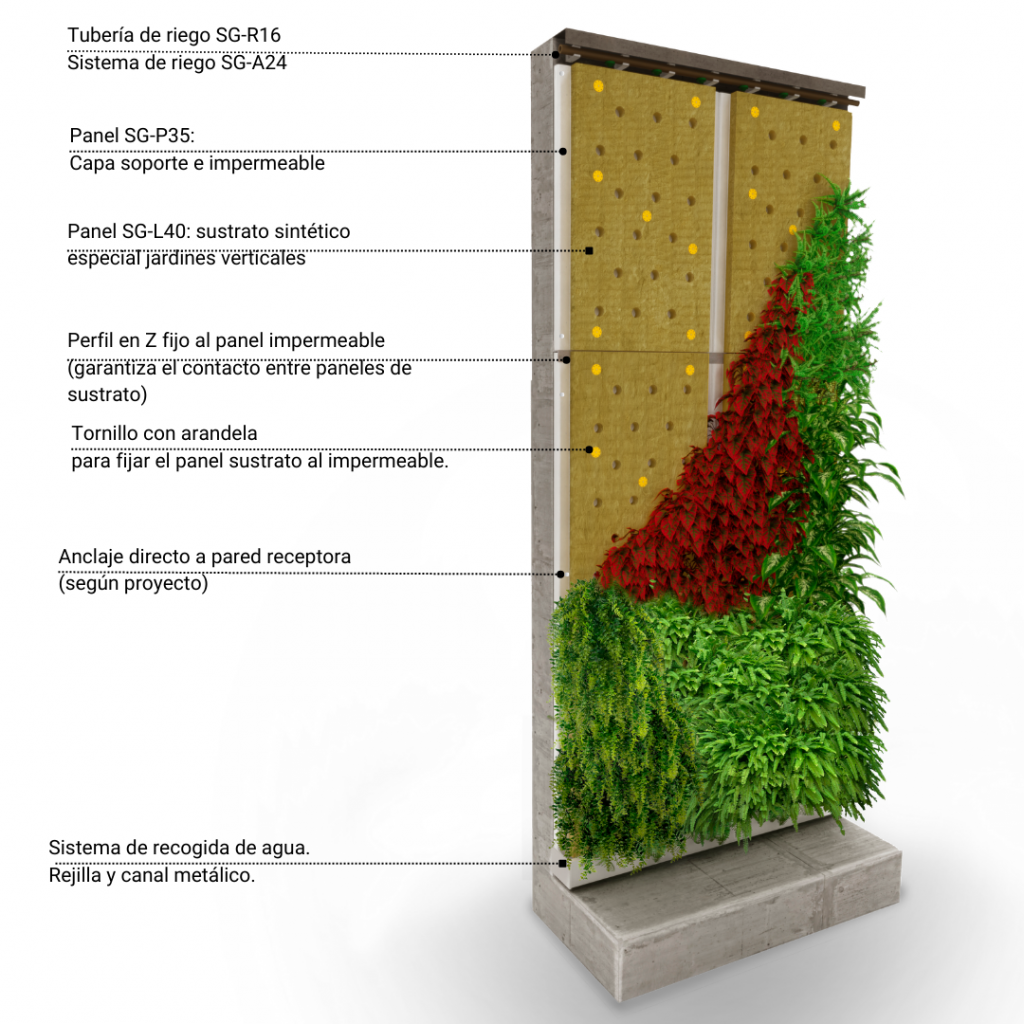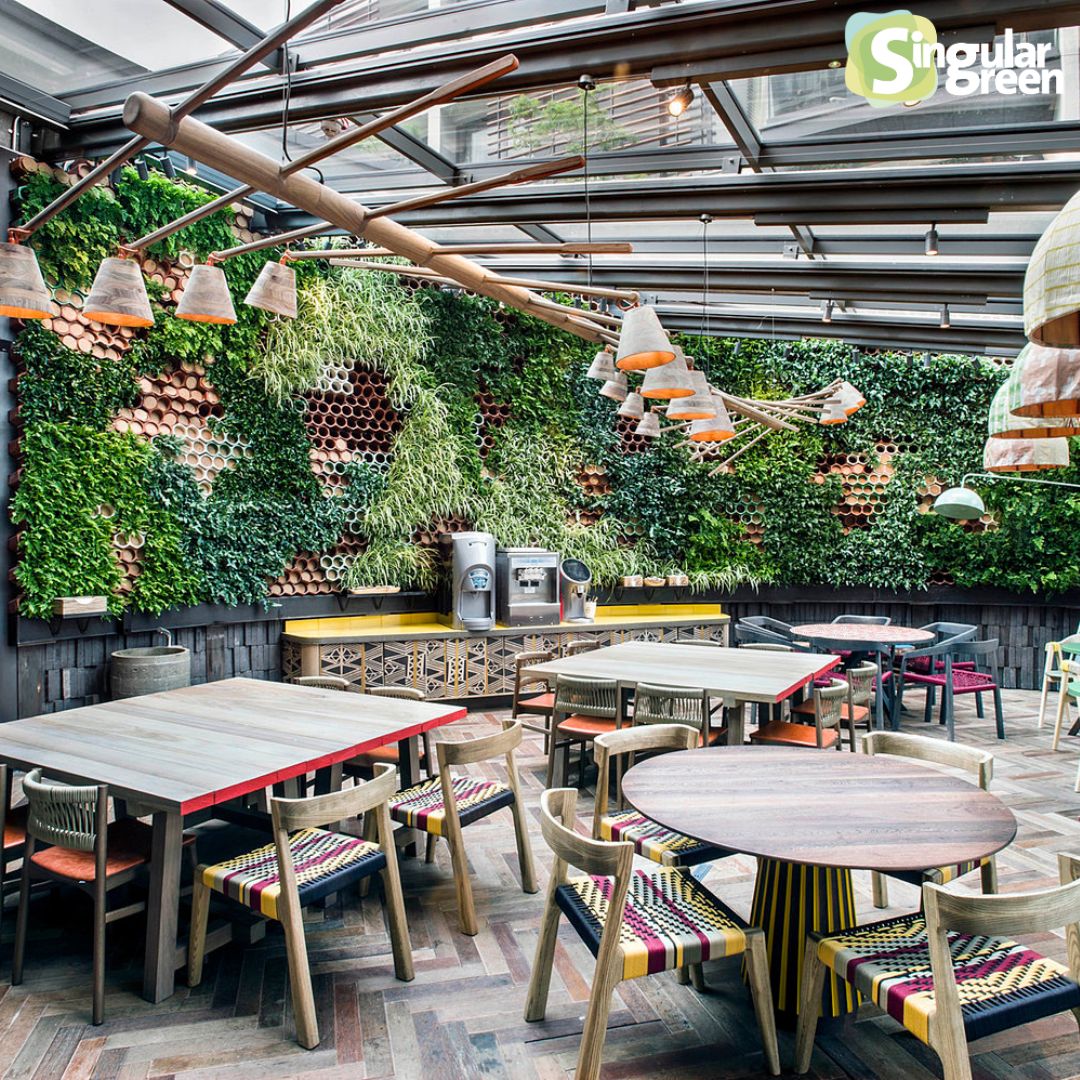Are you a planner, architect or designer and want to know quickly what aspects you need to know to design a vertical garden (either outdoors or indoors)?
In this article we will deal with the types of living walls, and other alternatives and all the keys to facilitate the implementation of these solutions in a concise and clear way.


We will make a quick review of its benefits, installation, construction systems, maintenance, types of vertical gardening and outstanding international examples, but if you want a technical conversation so that you can solve all your questions or those of your team, here you can schedule a meeting and clarify with our technicians all your doubts or questions.
Why include a vertical garden in my design?
There is no doubt that the future of architectural design is heading towards a more sustainable and ecological architecture, but there is also something that cities urgently need and the initiatives are also going in that direction, and that is their renaturalisation.
The benefits of nature in society, although they cannot be quantified economically, unequivocally bring benefits to people’s comfort and health.
Administrations are already starting this movement and have begun to establish specific regulations (e.g. the green factor in Madrid’s regulations) that encourage this type of solution,
Types of vertical gardens and the approach to their design
There are different types of vertical gardens that can be designed, but the main thing is to be clear about where they are located outdoors or indoors:
Outdoor vertical gardens
- Vertical gardens on building façades.
- Vertical gardens on outdoor garden walls.
- Use of creepers and climbing plants.
Indoor vertical gardens
- Vertical gardens in interior spaces such as living rooms or offices.
- Vertical gardens on interior walls for decoration.
- Use of indoor plants to create a green environment.
Vertical garden design guide for architects: Benefits of a vertical garden
- Improves indoor air quality by absorbing carbon dioxide and releasing oxygen.
- Provides a more relaxing and therapeutic environment, promoting emotional well-being.
- Helps reduce noise pollution by acting as a natural sound insulator.
Steps for the installation of a vertical garden
In order to carry out the installation of a vertical garden successfully, it is essential to follow a series of steps that guarantee its correct functioning and development. The following are the main aspects to be taken into account in this process
Location of the vertical ecosystem
- Choose a suitable location that receives the necessary amount of sunlight for the type of plants selected.
- Consider the orientation and shading of the space to avoid adverse situations for plant growth.
Selection of suitable plants
- Assess the climatic and environmental conditions of the site in order to choose plants that are adapted to these characteristics.
- Opt for hardy species that do not require constant maintenance and are suitable for a vertical environment.
Hydroponic garden irrigation system
- Implement an efficient irrigation system that ensures adequate hydration of the plants without generating excess moisture that can be harmful.
- Use technologies such as hydroponic irrigation to ensure an equitable distribution of water and nutrients throughout the vertical garden.
Construction system for vertical gardens
Hydroponic F+P system
The hydroponic F+P system is an innovative solution for the creation of efficient and easy to maintain vertical gardens. It consists of an automated irrigation system that uses dissolved nutrients to optimally feed the plants, guaranteeing their growth and proper development.
Characteristics of the hydroponic F+P system:
- Uses an inert substrate that allows for optimal root growth.
- Precise control of watering and plant nutrition.
- Reduces water consumption compared to other irrigation systems.
- Allows the installation of vertical gardens in indoor and outdoor spaces.
Advantages of the hydroponic F+P system:
- Greater efficiency in plant growth.
- Lower risk of diseases and pests.
- Low maintenance required.
- Possibility of automating the irrigation system.
Maintenance of living walls
- Regular maintenance of vertical gardens is crucial, especially during the first weeks after installation.
- To avoid stressing the plants, it is important to carry out care tasks such as humidity monitoring and proper nutrition of the plants.
- The maintenance process includes actions such as pruning dry or damaged leaves, controlling possible pests and regularly checking the irrigation system.
- In addition, regular check-ups are recommended to ensure that the vertical garden remains in optimal condition and continues to provide the desired benefits.
Examples of landscaping, or ways to incorporate nature into buildings
The possibilities for building design, facades, shading, and different aesthetics are manifold:




Construction details and technical documentation for the architectural project

| DETALLES CONSTRUCTIVOS: | FORMATO DWG | FORMATO PDF |
| PLIEGO DE CONDICIONES: | FORMATO DOCX | FORMATO PDF |
| PARTIDAS PRESPUESTARIAS: | FORMATO BC3 | ARQUIMEDES |
| DOSSIER TÉCNICO (Pautas diseño): | FORMATO PDF |






